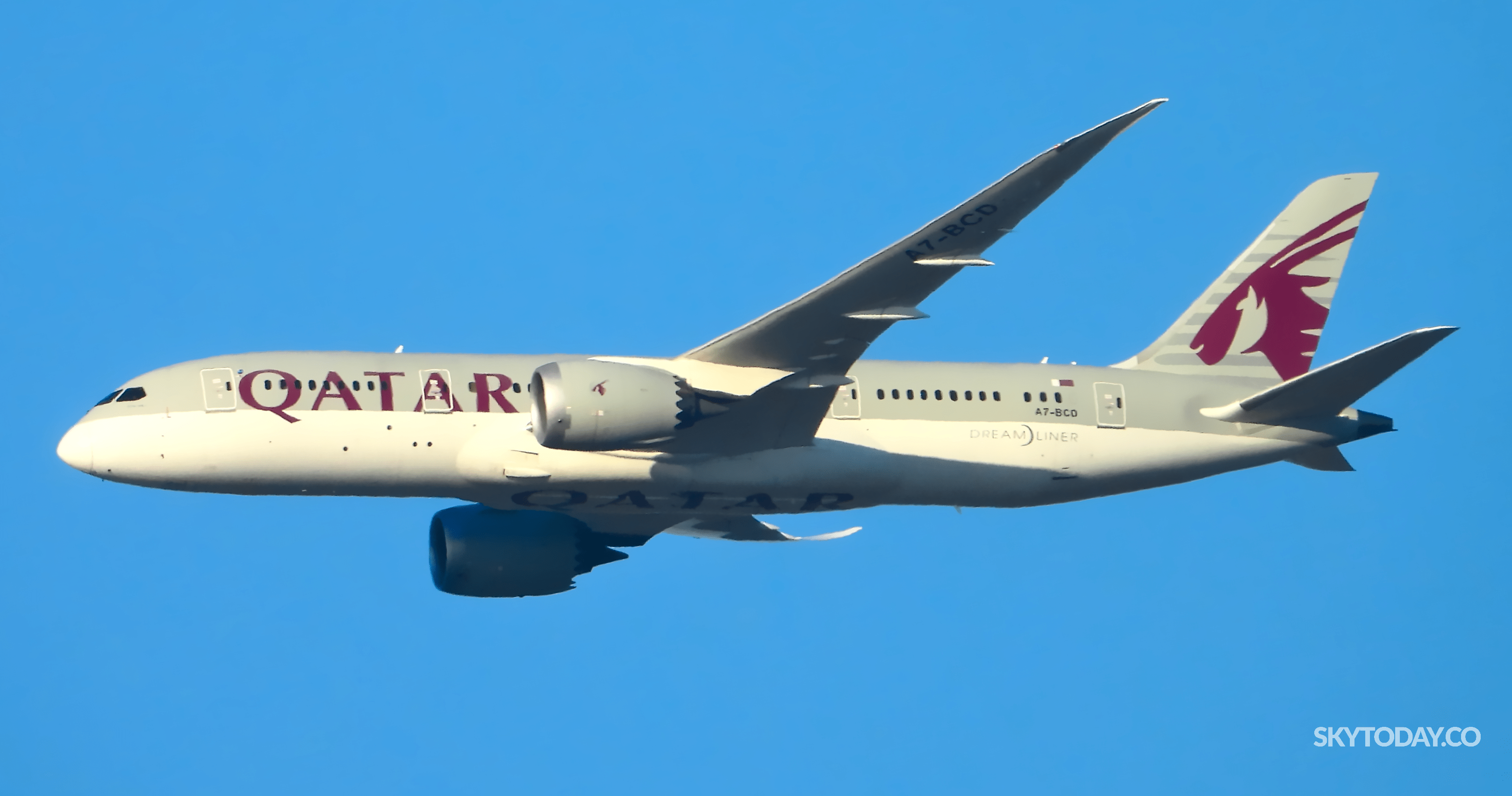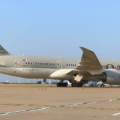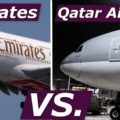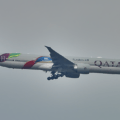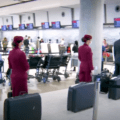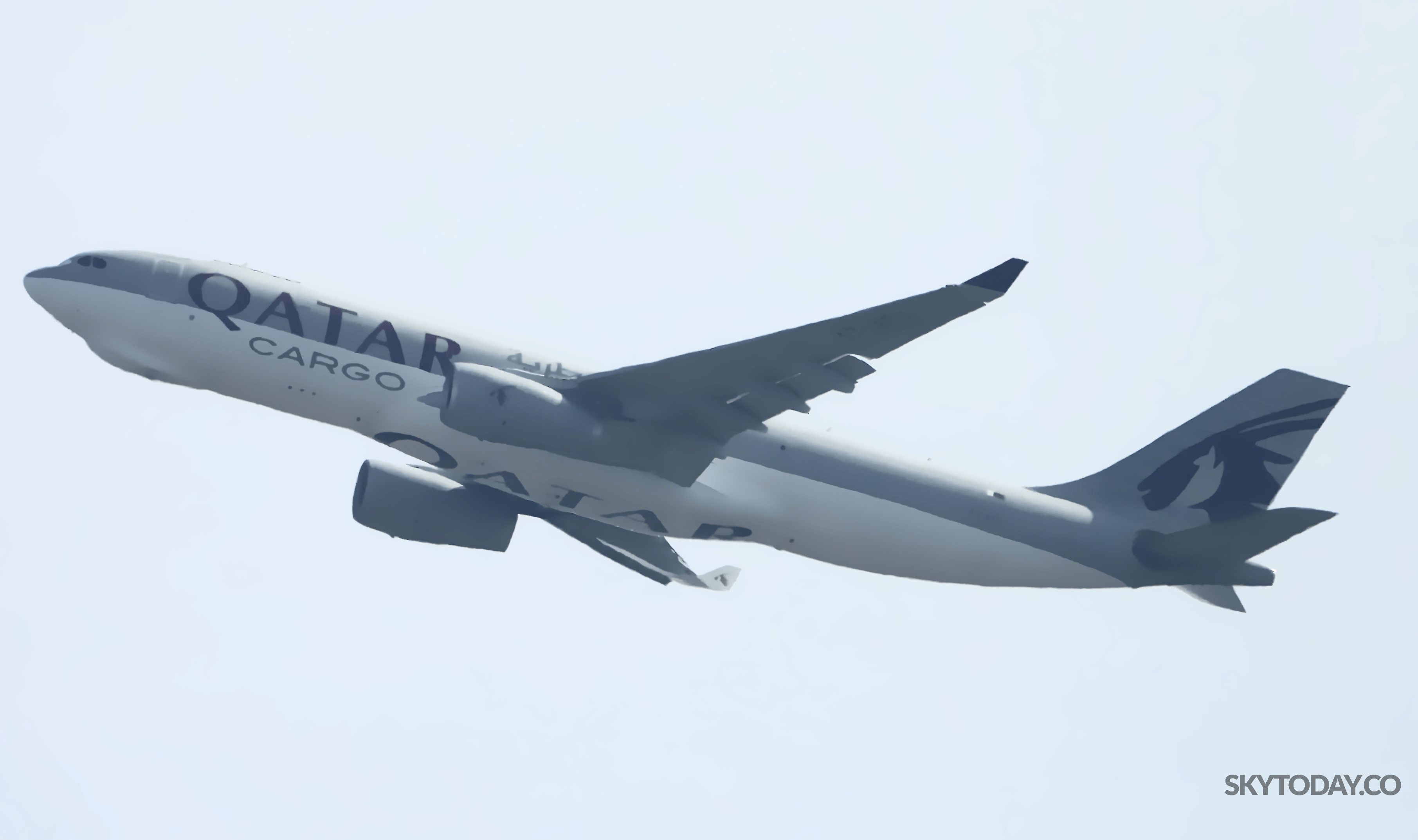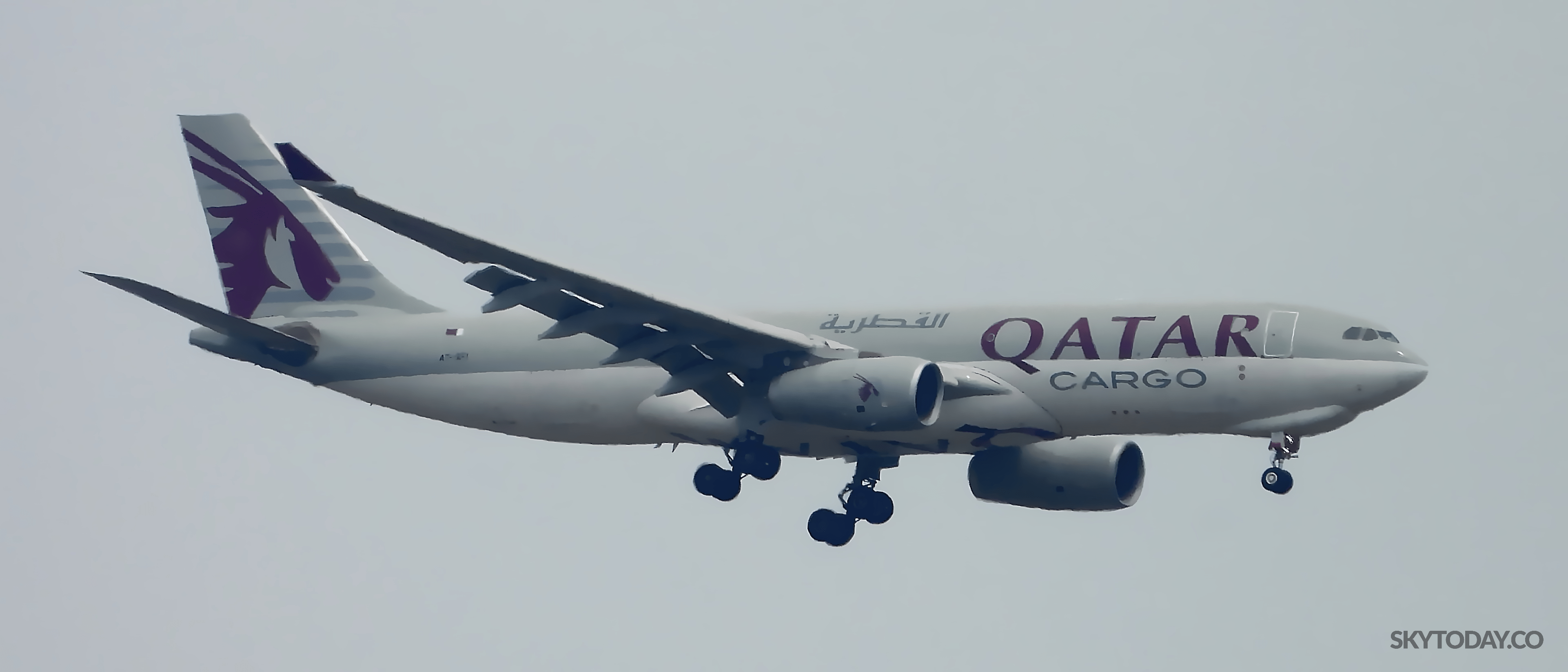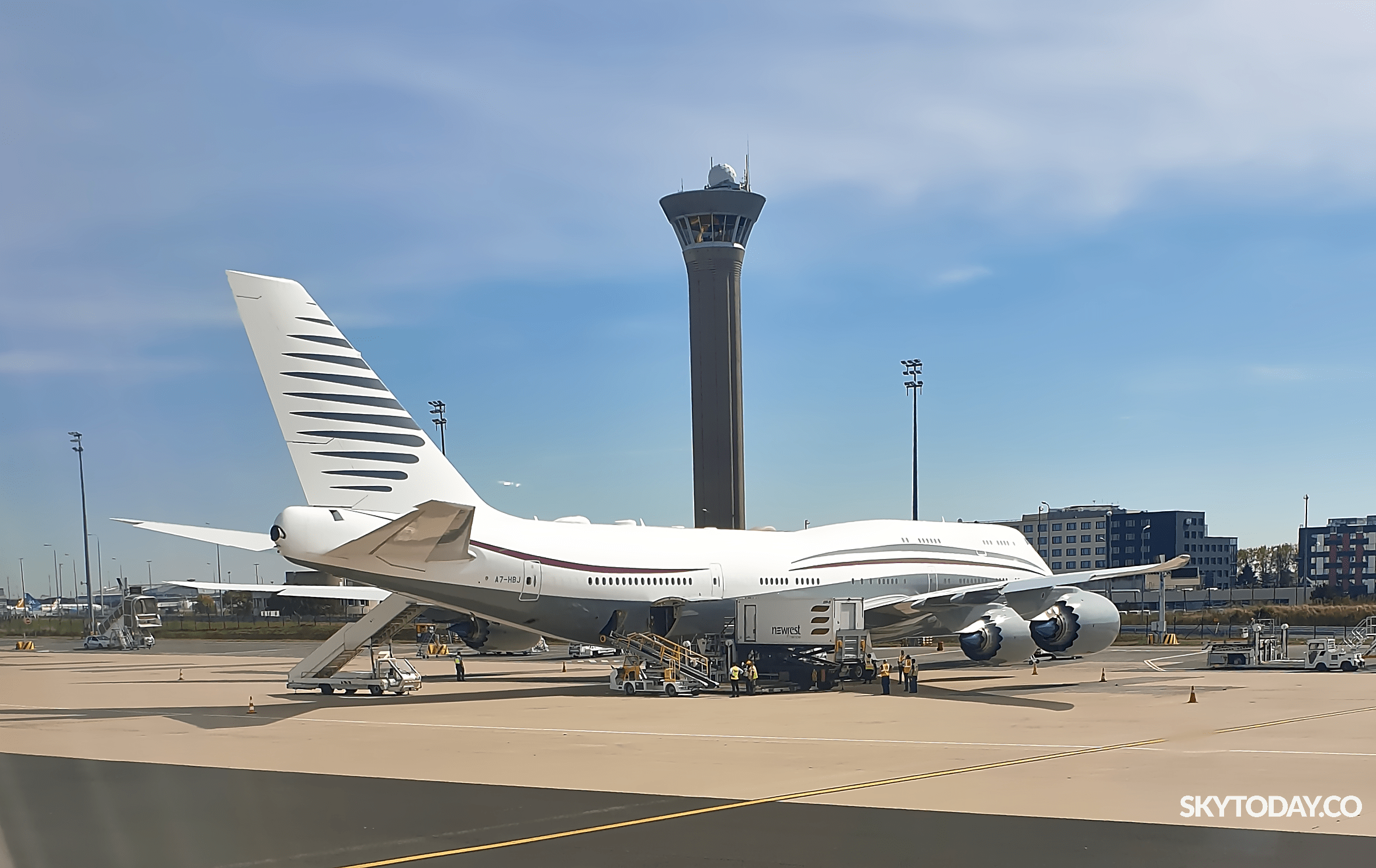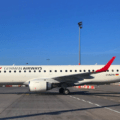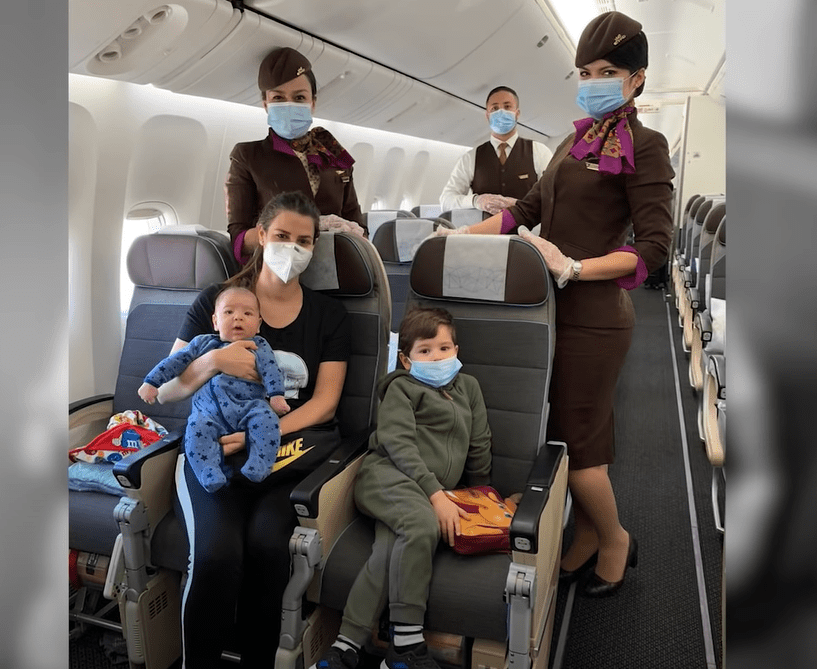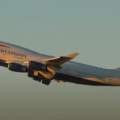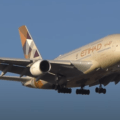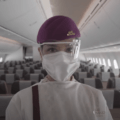Aviation
Qatar Airways

| IATA ICAO Callsign QR QTR QATARI | |
|---|---|
| Founded | November 22, 1993 |
| Commenced operations | January 20, 1994; 26 years ago |
| Hubs | Hamad International Airport |
| Frequent-flyer program | Qatar Airways Privilege Club (Qmiles) |
| Alliance | Oneworld |
| Subsidiaries | Qatar Airways Cargo The Qatar Aircraft Catering Company Qatar Airways Holidays United Media Int Qatar Duty Free Qatar Aviation Services Qatar Distribution Company Qatar Executive |
| Fleet size | 237 |
| Destinations | 172 |
| Parent company | Government of Qatar |
| Headquarters | Qatar Airways Towers, Doha, Qatar |
| Key people | Akbar Al Baker (CEO) |
| Revenue | |
| Net income | |
| Employees | 45,633 (Mar. 2018) |
| Website | www.qatarairways.com |
Qatar Airways Company Q.C.S.C. (Arabic: القطرية, al-Qaṭariya), operating as Qatar Airways, is the state-ownedflag carrier of Qatar. Headquartered in the Qatar Airways Tower in Doha, the airline operates a hub-and-spoke network, linking over 150 international destinations across Africa, Asia, Europe, the Americas, and Oceania from its base at Hamad International Airport, using a fleet of more than 200 aircraft. Qatar Airways Group employs more than 43,000 people. The carrier has been a member of the Oneworld alliance since October 2013, the first Gulf carrier to sign with one of the three airline alliances.
History
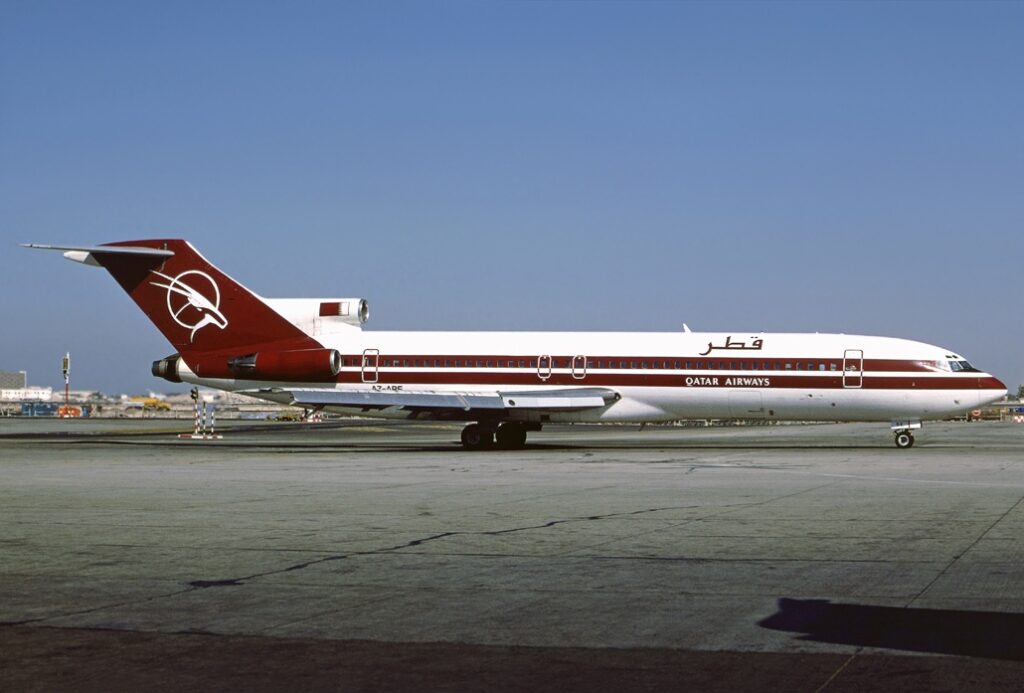
Source: Perry Hoppe
Qatar Airways was established on November 22, 1993; operations started on January 20, 1994. Amman was first served in May 1994. In April 1995, the airline’s CEO was the Sheikh Hamad Bin Ali Bin Jabor Al Thani who employed a staff of 75. By this time the fleet consisted of two Airbus A310s that served a route network including Abu Dhabi, Bangkok, Cairo, Dubai, Khartoum, Kuwait, London, Madras, Manila, Muscat, Osaka, Sharjah, Taipei, Tokyo and Trivandrum. During 1995, two ex-All Nippon Airways Boeing 747s were bought from Boeing. The airline acquired a second-hand Boeing 747SP from Air Mauritius in 1996. A Qatar Airways Airbus A320-200 in old livery.
Services to Athens, Istanbul, Madras and Tunis were suspended in late 1996, whereas Calcutta and Muscat were removed from the route network in January and September 1997, respectively. Flights to London were launched during 1997. The airline also took delivery of two second-hand 231-seater Airbus A300-600R aircraft on lease from Ansett Worldwide Aviation Services (AWAS) during the year; they replaced two Boeing 747s. The entering of these two A300s into the fleet also marked the introduction of a new logo. A third A300-600R joined the fleet shortly afterwards, also on lease from AWAS. In July 1998 the carrier placed a firm order with Airbus for six Airbus A320s, slated for delivery between 2001 and 2005; it also took options for five more aircraft of the type. Also in 1998, the carrier struck a deal with Singapore Aircraft Leasing Enterprise (SALE) for the lease of four Airbus A320s, with deliveries scheduled between February and April 1999; these latter four aircraft were aimed at replacing the Boeing 727-200 Advanced fleet and to fill the capacity gap before the hand over of the first A320 from Airbus. The airline took delivery of the first A320 powered by Aero Engines V2500 on lease from SALE in February 1999.Airbus A340-600. The airline became a customer for the type in 2003.
A fourth A300-600R on lease from AWAS joined the fleet in April 2000. In October 2000, Qatar Airways ordered an International Aero Engines V2500-powered Airbus A319CJ and took an option for another aircraft of the type. The airline became the Airbus A380’s ninth customer in 2001 when two aircraft of the type were ordered, plus two options. Also that year, the airline resumed services to Jakarta. In 2002, the government of Qatar withdrew from Gulf Air. In June 2003, a Qatar Airways Airbus A320 was the first aircraft that resumed the international services to Iraq when it flew the Doha–Basra route. Also that month, Qatar Airways incorporated its first dedicated cargo aircraft to the fleet. It was an Airbus A300-600R that was converted to freighter in Germany for US$10 million. Also in June 2003, at the Paris Air Show, the carrier placed an order with Airbus valued at US$5.1 billion for two Airbus A321s, 14 Airbus A330s and two Airbus A340-600s. The deal included eight A330-200s and six -300s; it also included options for further six A330-300s and eight A340-600s. The first aircraft were scheduled to enter the fleet in 2004, with the A340-600 slated for delivery in 2006. During the year the airline started serving the Chinese market with the introduction of flights to Shanghai. Also in 2003, the carrier expanded its portfolio of destinations with the commencement of services to Manchester in April, Tripoli in November, and Cebu and Singapore in December. During the 2003 Dubai Air Show the airline firmed up an earlier commitment for two Airbus A380s and took options for another two of these aircraft. The value of the transaction was US$1.2 billion. It was also in 2003 that Qatar Airways became the first airline to be audited under the new IATA operational audit programme, IOSA.
The Qatar Airways Group —which included Qatar Airways, Doha International Airport and corporate business air services, ground handling and in-flight catering companies— reported its first profit ever for the fiscal year (FY) that ended on March 2004. The FY2004 saw the airline transporting 3.35 million passengers. Zurich became the carrier’s 53rd destination worldwide in July 2004;Yangon was added to the list of destinations in December the same year. A new service to Osaka was launched in March 2005.Its first A340 was delivered on September 8, 2006.
In May 2007, Qatar Airways and Airbus signed a memorandum of understanding (MoU) for the acquisition of 80 Airbus A350 XWBs, including 20 A350-800s plus 40 and 20 aircraft of the –900 and –1000 variant, respectively, with the first aircraft initially slated for delivery in 2013. The agreement was firmed up in June during the 2007 Paris Air Show; three more Airbus A380s were also made part of the order. In July the same year, during the unveiling ceremony of the Boeing 787 in Everett, Qatar Airways was recognised as a future customer for the type when its logo appeared on one side of the brand new aircraft. By that time, the airline had not acknowledged it had placed an order for a number of these new aircraft. In November the same year, a firm order for 30 Boeing 787-8s, plus options for 35 more aircraft of the –9 or –10 variant, was confirmed. The order also included 14 Boeing 777-300ERs, six Boeing 777-200LRs and seven Boeing 777Fs, whereas five more aircraft of the type were on option. The combined order was valued at US$13.5 billion. The airline took delivery of its first 335-seater Boeing 777-300ER in late November 2007. The route network grew further during 2007 with the incorporation of Newark in June, Nagpur —the carrier’s seventh destination in India— in September, and Stockholm in November. A new scheduled service to New York-JFK that commenced in November 2008 replaced the Newark route. The first two Boeing 777-200LRs were handed over by the aircraft manufacturer in February 2009.
On June 15, 2009, at the Paris Air Show, Qatar Airways ordered 20 Airbus A320 and 4 Airbus A321 aircraft worth $1.9bn.
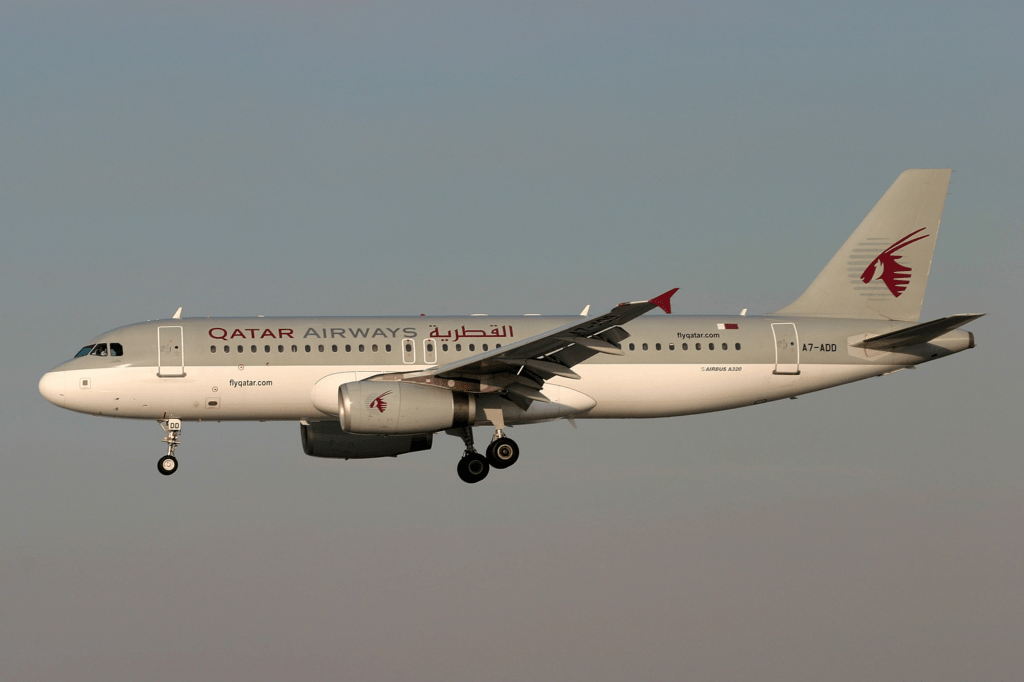
Source: http://www.airliners.net/photo/Qatar-Airways/Airbus-A320-232/0835245/L/
On October 12, 2009, the company completed the world’s first commercial passenger flight powered by a fuel made from natural gas, Also in 2009, Qatar Airways launched its first scheduled flights to Australia with Melbourne being the first city served; routes to Chengdu, Hangzhou, Phnom Penh and Clark International Airport in the Philippines were launched during 2009 as well.
Tokyo-Narita was first served by the carrier in April 2010. On May 18, 2010, the airline put its first Boeing 777F (A7-BFA) into service, with a flight from Doha to Amsterdam. The aircraft had been delivered on May 14, 2010.
The airline has launched 22 new destinations since 2010, with nine more destinations announced: Ankara, Aleppo, Bangalore, Barcelona, Brussels, Bucharest, Budapest, Buenos Aires, Copenhagen, Hanoi, Montreal, Nice, Phuket, São Paulo, Shiraz, Kolkata, Medina, Oslo, Sofia, Stuttgart, Venice and Tokyo. Qatar Airways also launched Benghazi and Entebbe during 2011. Service to Baku and Tbilisi, originally planned for 2011, was delayed until February 1, 2012, due to “operational issues”.
Boeing’s handover of a Boeing 777-200LR in September 2011 marked Qatar Airways receiving its 100th aircraft from this aircraft manufacturer. In November the same year, at the Dubai Airshow, the airline ordered 55 Airbus planes: 50 A320neo and 5 A380, in addition to two Boeing 777 freighters.
In July 2012, Perth became the second city served in Australia. On October 8, 2012, Qatar Airways announced its intention to join the Oneworld alliance.
On November 12, 2012 Qatar Airways became the seventh carrier worldwide to acquire the Dreamliner, when Boeing handed over the airline’s first aircraft of the type; it was the first delivered to a Middle Eastern airline. The aircraft was deployed on the Doha–Dubai corridor on Nov. 20 Dreamliner services on the long-haul Doha–London-Heathrow route commenced on Dec 13, with the airline becoming the first one to offer regular services to the United Kingdom using this aircraft. During 2013, Qatar Airways launched flights to Gassim in Saudi Arabia, Basra and Najaf in Iraq, Phnom Penh, Salalah and Chicago. Services to Ethiopia began in September 2013.
In February 2013, Qatar Airways opened its European Customer Service centre, which is in Wrocław, Poland.
In June 2013, the airline firmed up an order for two Boeing 777-300ER aircraft plus seven options. On November 17, 2013, the first day of the Dubai Airshow, Qatar Airways purchased 50 Boeing 777-9Xs. The commitment was firmed up during the 2014 Farnborough Air Show in a deal worth US$18.9 billion; purchase rights for another 50 aircraft of the type were also taken. In addition, the transaction included firm orders for four Boeing 777Fs plus options for another four with a combined value of US$2.7 billion. Deliveries of the passenger aircraft are expected to start in 2020.
An all-business class flight to London-Heathrow was launched in May 2014 with Airbus A319LR aircraft. Flights to Edinburgh were launched in May 2014. The carrier expected to take delivery of its first three Airbus A380 aircraft in June 2014, with plans for the aircraft to be displayed at the Farnborough Air Show. There were intentions to first deploy the type on the Doha–London-Heathrow route starting jun 17; another two undisclosed European points would likely become served with the A380. In late May 2014, it was reported the delivery of the aircraft would be delayed by several weeks. Further delays shifted the start of A380 services to London to August 1, 2014. Delivery of the first aircraft of the type finally took place on 16 September 2014. A380 services to London commenced in October 2014. The airline became the launch customer for the A350 XWB; the first Airbus A350-900 was handed over to the company on December 22, 2014 and had its first revenue flight to Frankfurt almost a month later, on January 15, 2015.
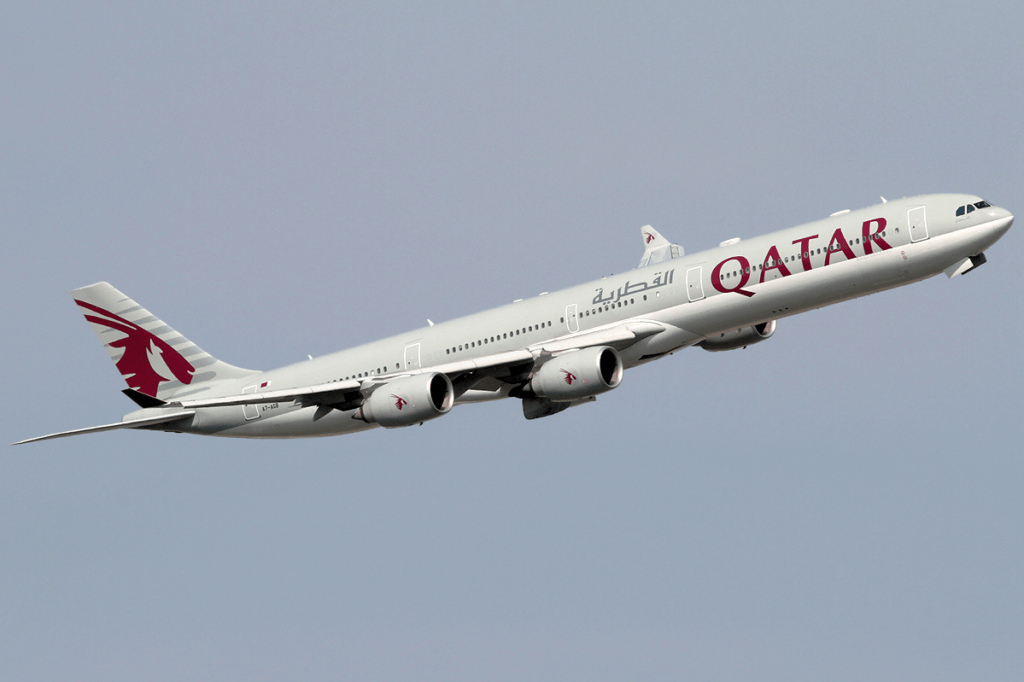
Source: http://www.airliners.net/photo/Qatar-Airways/Airbus-A340-642/2422905/L/
In January 2015, the airline concluded an order for four Boeing 777Fs in a deal worth US$1.24 billion; Qatar Airways also took purchase rights on four more aircraft of the type. In June 2015, it was disclosed Qatar Airways ordered ten Boeing 777-8Xs and four additional Boeing 777Fs for US$4.18 billion.
In January 2016, the carrier received its first Boeing 747 nose loader.
As of 5 February 2017, the airline had the longest regularly scheduled flight of a commercial airline, between Doha and Auckland. It has since lost the title to Singapore Airlines’ Newark to Singapore route, which was first operated on October 11, 2018.
In September 1, 2017, it was announced that Qatar Airways bought 49% of AQA Holding, the new shareholder of Meridiana.
In November 2018, the airline announced it would expand its flights to Iran, landing at Tehran and Shiraz, as of January 2019, and to Isfahan in February.
In December 2018, the CEO of Qatar Airways, Akbar Al Baker, threatened to pull the company out of the Oneworld alliance in February, following accusations that alliance members Qantas and American Airlines engaged in “hostile business practices” against his carrier.
On April 30, 2019, Qatar Airways retired its last Airbus A340-600 from service after around 16 years of service. The last flight was QR835 from Bangkok Suvarnabhumi International Airport to New Doha International Airport. The removal from service was to lower the age of its fleet as well as its ineffectiveness compared to the Boeing 777 as stated by CEO Akbar Al Baker in 2009.
Corporate affairs
Key people
As of June 2017 the Qatar Airways’ CEO is Akbar Al Baker,] who has been serving in this position since November 1996. Baker is also a member of the Heathrow Airport board.
Ownership and subsidiaries
As of May 2014, the company is fully owned by the Qatari government. Qatar Airways has been fully controlled by the government since July 2013, following the buyout of a 50% stake from a former foreign minister and other shareholders. As of July 2018, the Qatar Airways Group employs more than 45,000 people; 32,000 of them work directly for the airline. Qatar Airways is as of February 2020 the largest shareholder in International Airlines Group (IAG) with 25.1% of the shares.
Divisions
Qatar Airways has many divisions including: Qatar Aircraft Catering Company, Doha International Airport, Qatar Airways Holidays, United Media Int, Qatar Duty Free, Qatar Aviation Services, Qatar Distribution Company, and Qatar Executive.
Cargo

Source: Konstantin von Wedelstaedt

Source: Jules Meulemans
Qatar Airways Cargo, the airline’s freight branch, is the world’s third largest international cargo carrier. Dedicated cargo flights to Cairo International Airport were launched in June 2009 complementing the passenger services already operated.
On August 18, 2010, the airline launched its first US dedicated cargo service from its hub in Doha to Chicago-O’Hare with a stop-over in Amsterdam, Netherlands using Boeing 777 freighter aircraft.
On March 13, 2013, Qatar Airways Cargo first of three A330F was delivered provided on lease from BOC aviation replacing A300-600F.
Global Supply Systems operated three Boeing 747-8F aircraft under a wet lease arrangement for British Airways World Cargo until BA terminated the contract early on January 17, 2014. An agreement with Qatar Airways to operate flights for IAG Cargo using Boeing 777F was announced on the same day.
On March 18, 2015, Qatar Airways Cargo announced that starting April 4, 2015, will launch a twice-weekly Boeing 777 Freighter service to Los Angeles which will become Qatar Airways Cargo’s fourth US freighter destination alongside Houston, Chicago and Atlanta.
On December 27, 2016, Qatar Airways Cargo has announced that it will launch freighter operations to four new destinations in the Americas, Boeing 777 freighters will fly twice a week to the South American cities of Buenos Aires, São Paulo, Quito and the North American city of Miami starting 2 February 2017.
Qatar Executive
Qatar Executive is a corporate jet subsidiary of Qatar Airways, with its livery sporting a white fuselage with a slightly smaller Oryx painted in the airline’s traditional colours of burgundy and grey.
The Royal fleet of Qatar Amiri Flight is also painted in full Qatar Airways livery, although they are not part of the airline or Qatar Executive.
Al Maha Airways
Al Maha Airways was a proposed airline based in Saudi Arabia fully owned by Qatar Airways. It used a similar livery, except in green instead of burgundy. It was planned to launch in September 2014 and by May 2015 the airline had already taken delivery of 4 Airbus A320 aircraft.
In February 2017, Qatar Airways announced that the Al Maha Airways project had been cancelled and the airline would not start operations due to ongoing issues gaining its operational license.
Livery
Qatar Airways has an oryx, the national animal of the State of Qatar, as its logo. The aircraft decor includes the word Qatar appearing in burgundy-coloured letters on a light grey background at both sides of the forward part of the fuselage with the word Al Qataria in Arabic titles appearing close to it in a darker grey and a smaller typeface. A burgundy oryx in a grey background adorns the tailfin. The airline unveiled this branding in 2006.
Natural gas to liquid fuel demonstration
On October 12, 2009, a Qatar Airways Airbus A340-600 conducted the world’s first commercial passenger flight using a mixture of kerosene and synthetic gas-to-liquids (GTL) fuel, produced from natural gas, on its flight from London’s Gatwick Airport to Doha. The experiment’s purpose was to demonstrate the viability of jet fuel made from a source not subject to rapidly fluctuating oil prices. Also, positioning natural gas in particular as an alternative source of jet fuel is in the interests of the Qatari government; Qatar is the world’s leading exporter of natural gas. However, some experts believe that GTL fuel is likely to remain a marginal choice due to an expensive production process.
Sponsorships
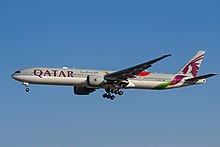
Source: N509FZ
- Qatar Airways has sponsored weather forecasts on Sky News since August 2005.
- In July 2013, Qatar Airways became FC Barcelona’s primary shirt sponsor. This sponsorship ended in 2017.
- In August 2016, Qatar Airways became Official international Airline Sponsor for Sydney Swans.
- In May 2017, Qatar Airways became FIFA Partner and 2018 and 2022 FIFA World Cups official sponsor.
- In May 2017, Qatar Airways became the “Official Airline Partner” for the FIA Fomula E Championship.
- In April 2018, Qatar Airways became A.S. Roma’s primary shirt sponsor.
- In July 2018, Qatar Airways became Boca Juniors’s primary shirt sponsor.
- In August 2018, Qatar Airways became a prestige partner and official airline sponsor for the 2018 Asian Games.
- In November 2019, Qatar Airways became the title sponsor of the Philippines Football League.
- In February 2020, Qatar Airways became the premium partner for Paris Saint-Germain F.C. for three seasons until 2022.
Investments
In 2015, they bought 9.99% of the International Airlines Group. Qatar has steadily increased its shareholding since then, and held 25.1% of the shares as at February 2020.
In December 2019, Qatar Airways purchased a 60% stake in Rwanda’s new $1.3 billion international airport, Bugesera International Airport. The MoU signed between Qatar Airways and the Rwandan government read, “The partnership features three agreements to build, own, and operate the state-of-the-art facility.”
In February 2020, Qatar Airways acquired a 49% stake in Rwanda’s flag carrier airline, RwandAir. The partnership is intended to be beneficial for both the airlines as it would provide technical and financial support to RwandAir for its development and hub strategy, while Qatar Airways would be able to bypass the embargo imposed by neighbouring countries.
Qatar Airways also invests a 10% stake in the LATAM Airlines Group.
They also own a 9.99% stake in Cathay Pacific.
Qatar Airways and jetBlue are minority shareholders in JSX.
Destinations
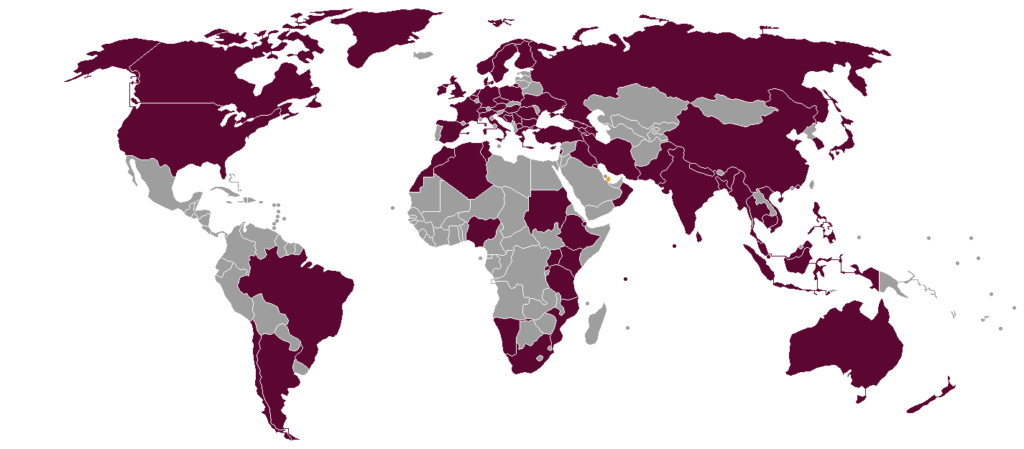
Source: Norvikk
On 27 May 2014, the touchdown of a flight from Bahrain at Doha’s Hamad International Airport marked the official transfer of Qatar Airways’ operations to its new hub, replacing Doha International Airport.
Fourteen additional destinations were added to the Qatar Airways network during 2012, including Addis Ababa, Baghdad, Belgrade, Erbil, Gassim, Kigali, Kiliminjaro, Maputo, Mombasa, Perth, Saint Petersburg, Warsaw, Yangon, and Zagreb.
As of December 2014, Qatar Airways served 146 points worldwide following the launch of flights to Asmara. The airline had previously added to the route network Dallas/Fort Worth, the carrier’s seventh destination in the United States and the second one in Texas along with Houston, Haneda, Miami, Edinburgh, its third destination in the United Kingdom, Istanbul’s Sabiha Gökçen International Airport, its third point served in Turkey, and Djibouti. Starting June 2015, the carrier will serve Amsterdam. Starting December 2015, it was announced the airline will serve Durban.
On October 8, 2012, Qatar Airways announced it would join Oneworld within the forthcoming 18 months. The entrance of the carrier into the alliance was mentored by British Airways. The joining ceremony took place on October 29, 2013 and Qatar Airways became the first major Gulf carrier to join an airline alliance.
Since June 2017, all Qatar Airways flights are barred from entering Emirati, Saudi Arabian, Bahraini, and Egyptian airspace and airports due to the 2017 diplomatic crisis. All airlines from these countries are also banned from Qatari airspace and airports.
On 18 June 2019, Qatar Airways launched its first flight from Doha to Davao, Philippines.
On July 1, three months after announcing Doha-Mogadishu flights, Qatar Airways launched its first flight to Somalia.
In August 2019, the company introduced flights to Langkawi, as a part of its expansion plans in Southeast Asia. The route is Qatar Airways’ third destination in Malaysia after Kuala Lumpur and Penang.
On September 8, 2019, Qatar Airways announced the launch of its flights to Luanda, Angola, starting March 2020.
Codeshare agreements
Qatar Airways has codeshare agreements with the following airlines and train systems:
- Air Botswana
- American Airlines
- Asiana Airlines
- Azerbaijan Airlines
- Bangkok Airways
- British Airways
- Cathay Pacific
- China Southern Airlines
- Comair
- Finnair
- Gol Transportes Aéreos
- Iberia
- IndiGo
- Japan Airlines
- jetBlue
- Lao Airlines
- LATAM Airlines Group
- Malaysia Airlines
- Middle East Airlines
- Royal Air Maroc
- Royal Jordanian
- S7 Airlines
- SUN-AIR
- SNCF (Railway)
- SriLankan Airlines
- Vueling
Fleet
Current fleet
As of April 2020, the Qatar Airways fleet consists of the following aircraft:
Qatar Airways fleet
|
Aircraft
|
In service
|
Orders
|
Passenger |
Notes
|
|||
| F | J | Y | Total | ||||
| Airbus A319-100LR | 2 | — | — | 8 | 102 | 110 | |
|
31
|
—
|
—
|
12
|
132 | 144 |
To be phased out by 2024
To be replace by Airbus A321neo. |
|
| 120 | 132 | ||||||
| Airbus A321-200 | 5 | — | — | 12 | 170 | 182 | |
| Airbus A321LR | — | 10 | — | 16 | 150 | 166 | Deliveries to begin in 2020. |
| Airbus A321neo | — | 40 | — | 16 | 150 | 166 | |
| Airbus A330-200 | 6 | — | — | 24 | 236 | 260 |
To be phased out by 2022.
To be replaced by Airbus A350 and Boeing 787. |
| Airbus A330-300 | 13 | — | — | 30 | 275 | 305 | |
| Airbus A350-900 | 34 | — | — | 36 | 247 | 283 |
Launch customer.
|
| Airbus A350-1000 | 14 | 29 | — | 46 | 281 | 327 | |
| Airbus A380-800 | 10 | — | 8 | 48 | 461 | 517 | To be phased out from 2024. |
|
9
|
—
|
—
|
42
|
217 | 259 |
To be phased out by 2024.
To be replaced by Boeing 777X series. |
|
| 230 | 272 | ||||||
|
48
|
—
|
—
|
42 | 316 | 358 | ||
| 42 | 312 | 354 | |||||
| 24 | 388 | 412 | |||||
| Boeing 777-8 | — | 10 | TBA | ||||
| Boeing 777-9 | — | 50 | TBA | Order with 50 purchase rights. | |||
| Boeing 787-8 | 30 | — | — | 22 | 232 | 254 | |
| Boeing 787-9 | — | 23 | TBA | Seven aircraft stored at Victorville | |||
| Qatar Airways Cargo fleet | |||||||
| Airbus A330-200F | 5 | — | Cargo | To remain until end of 2020. | |||
| Boeing 747-8F | 2 | — | Cargo | ||||
| Boeing 777F | 21 | 5 | Cargo | ||||
| Total | 237 | 167 | |||||
Note: Though not affiliated with the airline, some VIP aircraft belonging to the Royal family and Government are also painted in Qatar Airways livery and operate as Qatar Amiri Flight.
Qatar Executive Fleet
As of March 2019, the Qatar Executive fleet consists of the following aircraft:
Qatar Executive Fleet
| Aircraft | In Service | Orders |
| Bombardier Challenger 605 | 1 | 0 |
| Bombardier Global 5000 | 2 | 0 |
| Bombardier Global Express XRS | 2 | 0 |
| Gulfstream G650ER | 6 |
27
|
| Gulfstream G500/G600 | 5 | |
| Total | 16 | 27 |
Previously operated
Qatar Airways formerly operated the following aircraft:
| Aircraft | Introduced | Retired | Notes | ||
| Airbus A300-600R | 1997 | Unknown | |||
| Airbus A300-600RF | 1997 | 2013 | |||
| Airbus A310-200 | 1994 | 1995 | Leased from Airbus | ||
| Airbus A340-600 | 2003 | 2019 | |||
| Boeing 727-200/Adv | Unknown | 2001 | |||
| Boeing 747-100B | 1995 | Unknown | |||
| Boeing 747SP | 1996 | Unknown |
Cabin

Source: Travelarz
First class
Qatar Airways offers first class passengers over 6.5 feet of legroom and seats that fold into flat beds with feather duvets. First class seats are equipped with massage functions and an entertainment system. First class, available only on A380s, features a 90-inch seat pitch, transforming into a fully flat bed, together with an expansive choice of entertainment options displayed on individual 26-inch television screens. It is configured as 1-2-1. All new Airbus A350 and Boeing 787 Dreamliner aircraft will be in standard two-class configuration.
Business class

Source: Raymondeuro
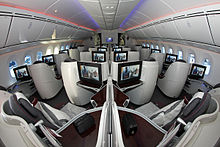
Business Class cabin.
Source:
Shahram Sharifi
Qatar Airways offers business class passengers fully flat horizontal beds with direct aisle access in a 1-2-1 configuration on board its Airbus A380, Airbus A350, Boeing 777, and Boeing 787 aircraft. On other long and medium-haul aircraft, business class seats are in a 2-2-2 configuration offering flatbed seats with 180 degrees recline, with massage functions.
Qatar Airways has introduced new business class seats on board its newly delivered A320 aircraft with IFE seat-back PTVs in every seat. It will introduce the new seats in each upcoming new A320 aircraft, as well as retrofitting 4 existing A321 and 2 A319LR aircraft.
In March 2017, Qatar Airways revealed a new business class cabin, dubbed “Qsuite.” The new cabin offer suites with doors arranged in a 1-2-1 configuration. Qsuite features single seats on the window sides, and the middle section suites can be converted into a quad room, allowing four passengers to face each other in a dining-room like set up. Additionally, select “couple” seat pairs in the middle section can be converted into a double bed, offering a product similar to what other airlines offer in First Class. Launched on new Boeing 777-300ER and A350 XWB aircraft from summer 2017 and initially introduced on the Doha to London Heathrow route, the new seats will be retrofitted in the remaining fleet progressively, excluding the Airbus A330s and Airbus A380s due to their upcoming retirement of the types beginning in 2019 and 2024 as Qatar Airways introduced the Airbus A350, Boeing 787, and Boeing 777X to replace them.
Economy class

Source: Alex Beltyukov – RuSpotters Team
Qatar Airways economy class was named best in the world in the 2009 and 2010 Skytrax Awards. Qatar Airways offers economy class passengers a seat pitch of up to 34 inches. Economy class passengers on A330 aircraft are offered individual seat-back TV screens. Passengers on Airbus A350, A380, Boeing 777 and 787 aircraft are offered touch-screen IFE monitors.
Qatar Airways has taken delivery of several A320 family aircraft so far with individual seat-back personal televisions in every seat in economy class. The IFE is equipped with the same Thales entertainment system as used in the widebody fleet. A further four A321s and the two A319LRs will be equipped with the new IFE, as well as new upcoming A320 family aircraft deliveries.
New economy seats will be introduced with the launch of the 787. These new seats will be produced by Recaro and are fitted in a 3-3-3 configuration. 16.9 inches of width and a pitch of 32 inches will offer less personal space than before. Furthermore, each seat will have a 10.6 inch in-seat LED monitor offering in-flight entertainment. The features will also extend to the possibility of Wi-Fi and GSM telephony usage and USB ports for connecting personal items such as digital cameras.
In-flight entertainment
Qatar Airways’ in-flight entertainment system is called Oryx One. With the exception of some Airbus A320 family aircraft, all aircraft have personal seat-back Info-tainment screens. Some Airbus A320 family aircraft are fitted with main screen entertainment. Qatar is updating Airbus A320 family aircraft to seat-back AVOD. Qatar Airways also offers Onboard Connectivity Wi-Fi, which allows passengers to send SMS and MMS, access email, and browse the internet. This service is available on all A380, A350, B777, B787, A319, and select A320, A321, and A330 aircraft.
Privilege Club
Qatar Airways’ Privilege Club loyalty program has reciprocal agreements with Middle East Airlines, Royal Air Maroc and Gol Transportes Aéreos.
Lounges
After full operations commenced at its new hub, Doha in 2014, the Al Mourjan Business Lounge for Qatar Airways’ premium passengers opened in July 2014. Al Mourjan Business Lounge is about 10 times the size of an Olympic swimming pool and lounge access is for Qatar Airways and Oneworld first and business class passengers only.
In 2015 Qatar Airways opened the Al Safwa First Lounge for its first class passengers. The lounge received the prestigious Seven Star First Class Lounge Award at the Seven Stars Luxury Hospitality and Lifestyle Awards in Marbella, Spain on October 15.
The airline’s first lounge outside Doha opened at London Heathrow’s Terminal 4 in January 2012 and Qatar Airways opened its new Premium Lounge at Dubai-International’s Concourse D in April 2016. In January 2017, Qatar Airways opened its new premium lounge within Terminal 1 at Charles de Gaulle Airport.
Incidents
- April 19, 2007: An Airbus A300, registration A7-ABV, was written off as a result of a hangar fire during maintenance at Abu Dhabi Aircraft Technologies.
- December 8, 2017: An Airbus A321-231 registration A7-AIB was damaged beyond economic repair by a fire at Hamad International Airport, Doha.
Controversies
Workplace controversies
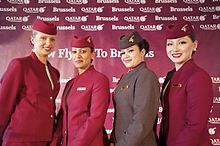
Source: qatar_inaugural__DSC6442
In 2013, The Economist claimed that “a perusal of online forums used by cabin crew suggests that Qatar has a reputation for severity among industry professionals, including “allegations of harsh treatment and overbearing scrutiny are commonplace”, and that “the conditions laid down by Qatar Airways go beyond more familiar rules … the employee can be fired if she becomes pregnant (which she is contractually obliged to disclose ‘from the date of her knowledge of its occurrence’)”. The airways’ CEO Akbar Al Baker has previously stated, “We are not running an intelligence agency, we are an airline company. The reason why I know everything happening in the company is … I’m simply everywhere, talking to everyone, listening to them”.
In 2014, the Swedish newspaper Expressen published a report ostensibly based around three Qatar Airways employees, whose lives were allegedly heavily “monitored” and “controlled” by the company. Qatar Airways’ Swedish PR agency responded to the report by stating, “Because we do not know which individuals and which particular cases the article is based on, Qatar Airways is unable to comment”. CEO Akbar Al Baker stated that the allegations “are not against [the company] but against [Qatar]”. He added, “They are throwing stones at my country for no reason at all”.
The International Transport Workers’ Federation (ITF) has “slammed” Qatar Airways for certain stipulations found in the standard hiring contracts for female cabin crew members, including the need to apply for permission before getting married. The ITF has lobbied the International Civil Aviation Organization to “take action” on what ITF termed “flagrant abuses of aviation workers’ labour rights” by carriers based in Qatar and the UAE.
In August 2015, Qatar Airways was forced to relax its policy of sacking cabin crew for getting pregnant or marrying in their first five years of employment. A spokeswoman stated, “our policies have evolved with the airline’s growth”. Under the new regulations, “we will provide an opportunity for someone to continue working in a ground position”, the spokeswoman said.
During an annual meeting of the International Air Transport Association in 2018, the CEO of Qatar Airways, Akbar Al Baker, claimed that a woman could not do his job as “it is a very challenging position.” Upon receiving backlash regarding his comments, Al Baker explained that he did not intend to refer to all women at Qatar Airways. He also mentioned that he would love to have a female CEO running the company after him. Since then, Al Baker has apologized for his comments in a statement that was provided to The Independent.
Competition issues
In 2016, American Airlines, Delta Air Lines, and United Airlines claimed that their forensic investigators had uncovered documents that allegedly indicated that Qatar Airways had received more than $7 billion in aid from the Qatari government. According to reports, the investigation was conducted by Wilmer Cutler Pickering Hale and Dorr LLP. In July 2016, the U.S. Department of State held talks with Qatar government officials regarding the allegations of unfair competition. No formal action was taken by the Department of State. Qatar Airways has denied allegations that subsidies were received and Qatar Airways CEO Akbar Al Baker condemned the accusations.
Source: wikipedia
